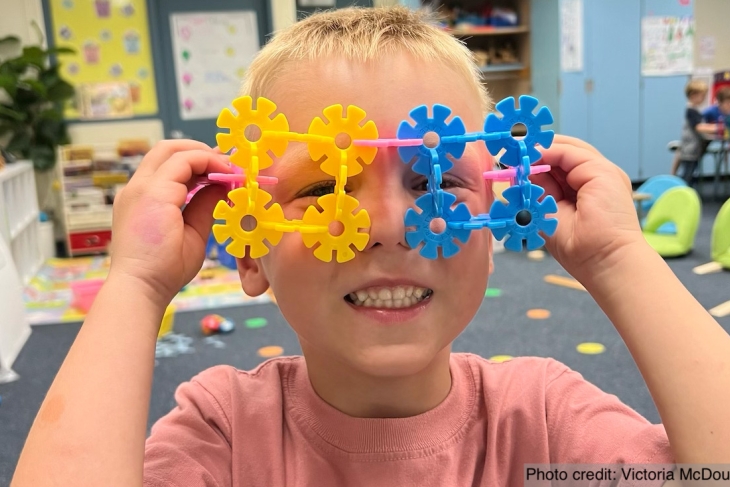When my son entered kindergarten at our local public school last fall, I never expected I’d have to become an ambassador and advocate for giftedness and gifted education. He has always been an eager, rapid learner—intensely curious and a social butterfly—so we expected his first year of elementary school to be one of mostly excitement, fun and joy.
Although our public school is well-known in the area for its strong gifted and talented education program, it isn’t available to students until third grade, missing the critical first years of schooling that lay the groundwork for all the learning and growth that follow. Yet research is clear that gifted children need additional challenges—outside the school’s standard curriculum—to stay engaged. They have high potential and high ability and often require services not provided by regular school programs.
Without an appropriately engaging, rigorous, and expanded curriculum, gifted children risk becoming bored, frustrated, or angry, and they may begin to disengage, misbehave, or act out at home or at school. Under-challenged gifted children are also denied a critical opportunity to face adversity—learn how to cope with mistakes, failure and disappointment—and develop other critical behavioral regulation skills that all young children should learn.
When I began asking questions, the adults I spoke to in my district were quick to offer myriad reasons for delaying the start of gifted programs until mid-elementary years (we don’t want to “rush” a child’s development, it’s difficult to test children in early elementary, there are so few of these children in a given grade that they just aren’t a priority in terms of resources, etc.).
But I wondered: Like my son, weren’t most gifted third graders already gifted when they were in kindergarten? Gifted children are present in all grade levels and in all types of populations. Children don’t wave a magic wand and become “gifted” halfway through elementary school. Why do we wait until the second or third grade to meet their needs? Why don’t we begin gifted services earlier? And if the problem is the lack of testing with which to identify gifted students, why don’t we start testing earlier? Districts are required to start identifying students with disabilities at age three; surely they could look for gifted students by age five.
Frustrated, I began to research California’s gifted policies (or as I soon discovered, their lack thereof).
While California has some state program standards and guidelines for gifted education, unlike almost all other states, it does not have a state definition of “gifted” written anywhere in law. As outlined in a 2020–21 report by the National Association for Gifted Children and the Council of State Directors of Programs for the Gifted, California also does not have a state law or rule that mandates the identification of gifted children or that requires gifted teacher training (this is all left to the discretion of local school districts and public charter school networks). The state does not provide dedicated funding to support gifted education, doesn’t track how many students are identified as gifted and talented in California, and does not have specified minutes of gifted and talented services required by rule or law. Nor is professional learning for administrators on the nature and needs of gifted students required by the state. I could go on. All of this means that programs—when available at all—vary widely in content and quality; there isn’t even a low bar that needs to be met.
Gifted education has likely become even less of a priority for schools due to the Covid-19 pandemic, despite the 2022 National Assessment of Educational Progress scores showing large declines in reading and math at all levels. Yes, gifted children comprise a small subset of total enrollment, but their academic needs should be as much a priority as those of any other child. Gifted children are children first, and gifted second. All children deserve a challenging education that meets their academic and social and emotional needs.
Nor should the burden of advocacy fall on individual parents, many of whom aren’t education experts and who, like me, are already exhausted and overwhelmed by the many challenges of raising wonderful, spirited, intense gifted children. Equally overwhelmed, hardworking early elementary teachers and counselors also deserve more support and training so they’re equipped to identify and serve these students within school walls.
It’s long past time for California to fix its woeful laws and policies for gifted education. The state can and should do so much more to require the identification of gifted children, specify the services that should be provided to them, monitor the number of students participating and how they fare, and require gifted teacher training.
The state’s youngest minds simply deserve more, and they deserve it today.
Editor’s note: This was also published as an article in an edition of “Advance,” a newsletter from the Thomas B. Fordham Institute edited by Brandon Wright, our Editorial Director, and published every other week. Its purpose is to monitor the progress of advanced education (a.k.a. “gifted” education) in America, including legal and legislative developments, policy and leadership changes, emerging research, grassroots efforts, and more. You can subscribe on the Fordham Institute website and the newsletter’s Substack. The article was also published by EdSource.




